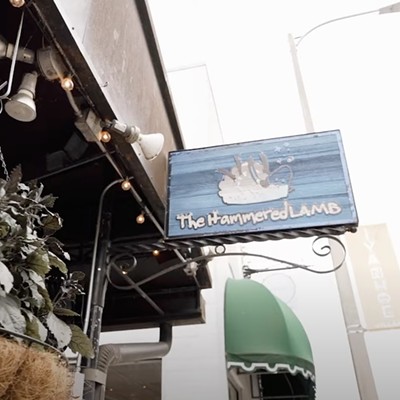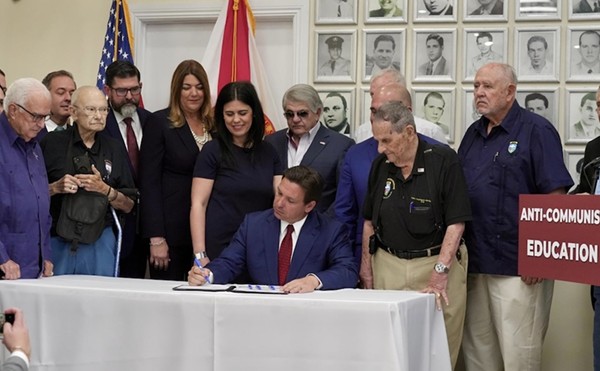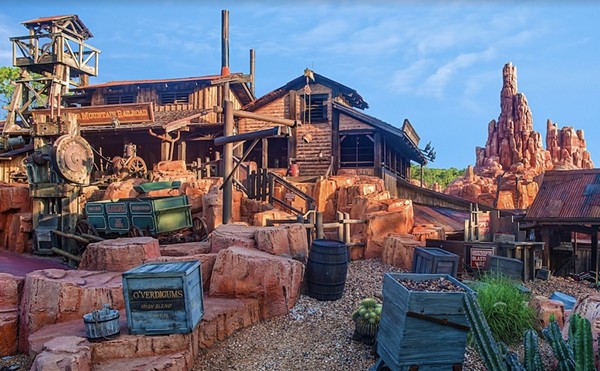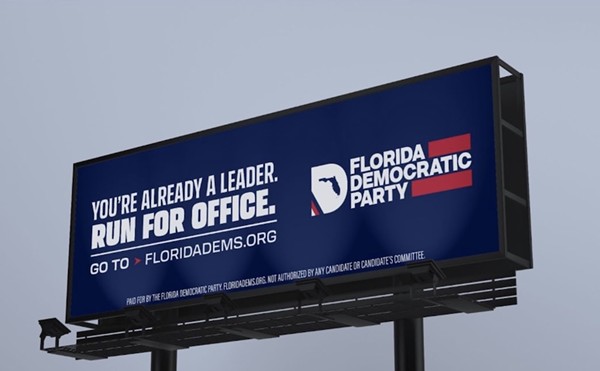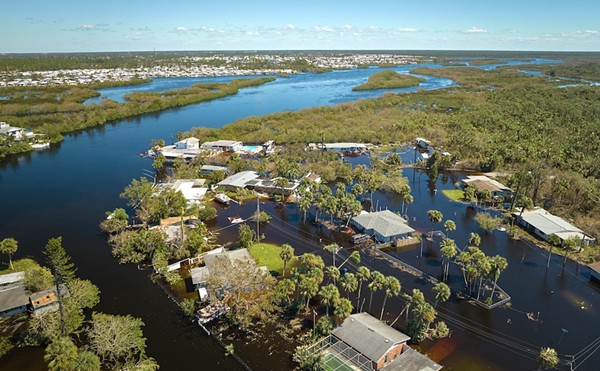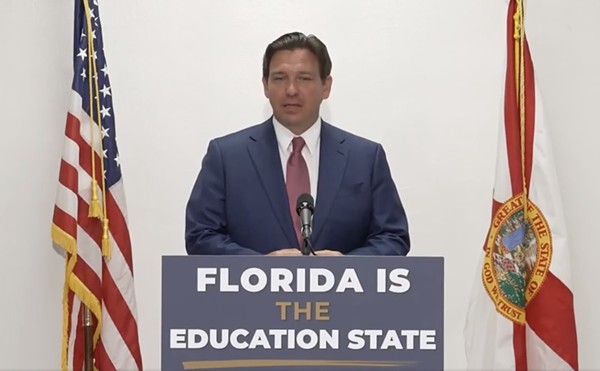I board a brightly colored Lymmo downtown at Central and Magnolia avenues at 4:20 p.m. on a Friday. Only a few people ride with me. The bus is clean, but louder than I expect for something called a "Lymmo." It moves freely in its own lane, but pauses frequently at stop lights.
Because the Lymmo is designed, in part, as a museum (or "moveum of art"), I look for educational panels to explain the art on the outside of the bus. I am disappointed to find only one relatively small informational piece posted over a seat. It is hard to read and no one else seems to notice it. The passengers ride like they do on any bus; they talk to a friend or quietly exist in their own private space.
This is a posh bus; it has tapestrylike fabric on the seats and cushioned handrails. A front-seat section can be folded up to accommodate people in wheelchairs. But I would never mistake this for a limousine; it is simply a brightly colored bus which, thankfully, provides public transportation for a small area of our downtown.
On Aug. 4, Orlando began running the Lymmo system, the free bus that runs from City Hall, past the new Orange County Courthouse, to the Centroplex. This $21 million project includes not only 10 brightly painted buses, but a major cityscaping effort. About 75 percent of the costs came from state and federal funds. The operating and maintenance budgets will be paid by revenues earned from public parking garages.
New concrete and brick, in varied patterns, colors and textures, was laid for the bus lanes and sidewalks. They are adorned with thousands of reflective ceramic pavement markers. Vertical planters now decorate the route, and hundreds of plants and trees are placed along the corridors.
It is hard to find anyone who is not thankful for new trees, safe and relatively efficient public transportation, and a clean, upscaled downtown. These new efforts help eliminate traffic congestion and encourage people to participate more fully in the downtown area.
But downtown is not yet a place where people enthusiastically choose to be. Like the University of Central Florida campus where I work, it has some pleasing buildings and greenery, but it desperately lacks a sense of community. Our downtown area fails in that it is too much like a theme park.
While the new buses physically link us from City Hall to the courthouse, there is little in downtown, besides the charm of renovated buildings, to connect us to our past, or entice us to address questions related to our future. The planned effort loses the chance to engage us long enough to linger, examine, interpret or dream. In a political, social and economic area as vibrant as ours, we should and could do far better. Because of my career as a university professor, I have the opportunity to travel rather frequently. I look for reasons to go to Seattle, San Francisco, New Orleans, Montreal, Vancouver, Nashville and New York. I like smaller towns, too: Charleston, Savannah, Key West, St. Johns in Newfoundland, Taos, N.M., and Kutztown, Pa. When people come visit me, often people who travel a great deal and know various cities, I rarely take them to downtown Orlando. It is not enticing enough.
Still, it is easy for me to entertain and dazzle even the most experienced, discerning visitor. I take them to Cassadaga to experience small-town Florida and a psychic reading; to Christmas to see old Cracker houses still in their original contexts; to Eatonville to better absorb Zora Neale Hurston's stories and her legacy; and to La Carretta restaurant (when it is open) in Apopka, for Mexican cuisine. We look at local botanicas (there's one on Bumby Avenue) and go down to Bealsville to visit Ruby Williams, who sells produce and folk art. This is a rich, varied cultural area. But downtown Orlando has a long way to go before it has the aesthetic or cultural "pull" of a town like Seattle or San Francisco. I can't imagine that Charles Kuralt would have wanted to spend a month living in downtown Orlando, as he did in a dozen places around the country while living out his "perfect year," unless he used it as a pivot point to take day trips.
Our city is growing up. It is becoming more economically vibrant and aesthetically more pleasing to look at. The infrastructure is being cared for and the arts are, at least verbally, touted as important. But what about the future?
An aesthetically pleasing downtown needs places to sit, fountains, easy access to shops, safe spaces to cross the roads and a variety of things on which to feast one's eyes. A downtown is a healthy, vibrant place when a diversity of people are visible. In this respect, Orlando has made a good beginning.
Eric Rosoff, general partner of Magnolia Partnership, Ltd., says what we need to do now is encourage people to take up residence downtown to make it more active. They could live on second floors, in loft-like spaces as they do in Winter Park and South Beach. He suggests small grocery stores, and more businesses like gas stations, barber shops and hair salons.
These are good suggestions, but Central Floridians deserve even more. We need spaces, large and small, in which to perform, sit, meditate, draw, recite poetry, debate and imagine. We need to see language written in all kinds of ways, listen to visionaries and eat ethnic food on a park bench. Since Orlando's wealth is its diverse citizenry, we should celebrate and make more visible our residents from Asia, the Caribbean and Latin America. We lack the visual and audio sounds of our makeup by laws which restrict too bluntly. We lack mimes, dancers, magicians and musicians -- people who could entertain us as we wait for the Lymmo. These artists are treasures in Boston. Why not Orlando?
A vibrant, aesthetically pleasing city not only draws you in with its beauty, but it reminds you of what it is to be human -- in all its varied ways. When we go downtown, we need to experience more of the pulse of living. We should be engaged, not just by trees and colorful buses, but in human dialogue, politics, environmental issues, historical spaces, economic realities and the keen awareness of what it means to breathe.
Many citizens and tourists may enjoy the theme-parklike feeling but it is not enough. We can appreciate the cleanliness, but we lack variety. We need to support our local artists and involve them in most aspects of city planning. A city working toward a richness in vegetation, architecture and mass transportation also needs public art, community art and narrative. An active city should be a place where people can come to play chess, checkers or dominoes. It should have free spaces for debate and storytelling. It needs to represent a citizenry varied in race, class, gender, age and physical ability.
While most everyone in the city dislikes the asparaguslike sculpture in front of City Hall, I have found no one who does not respond pleasantly to the view of rocking chairs on the same plaza. They are far less expensive, and they speak much more clearly about who we are and how we want to be seen. They evoke the identity of the South, friendly conversation and strong neighborhoods. Active, healthy communities, even neighborhoods centered in a downtown, need a clear recognition of who lives there.
Much more could be done to develop community and public art in Orlando. The city's public-art projects are funded by setting aside 1 percent of the budget for all new public buildings. For the last few years, this has meant that the budget has been about $35,000 a year. With such limited funds, outdoor projects are hard to support. Therefore, Frank Holt, who coordinates this effort for the city, has used the funds largely to purchase works to display inside public spaces. But too few people who do not work in City Hall or other public buildings ever see these art works. Art also should be outside, integrated into the spaces of people's daily lives. We should come upon it, like a great surprise, and not have to hunt for it.
When asked how cities like Seattle pay for their extensive and exciting public-art projects, Holt explains that their funding is linked not only to buildings, but work done on the city's infrastructure. Even Miami purchases public art with a percentage of the funds used for building its public-transportation system. If Orlando had also had this kind of formula in place for the last 15 years, our downtown would be quite a different place. Other possibilities for purchasing large-scale public art works can come from collaborative efforts organized in the early stages of new landscaping and architectural projects. One example of this kind of planning will result in a 65-foot hanging metal sculpture by Dorothy Gillespie in the new parking garage on South Street.
Site-specific art works created by people who call themselves professional artists is fundamental to a vibrant city. However, the aesthetics of an area also are made rich by its street people. While it is understandable that street vendors are not appreciated when they take tax dollars away from established businesses, it should also be evident that ethnic food stands and flower vendors have given New York, Key West and San Francisco character and interest. A sign installed 18 months ago with the expansion of Lake Eola Park points people toward an open-air food court; that court has never materialized. When we lure people inside because food and artistic activity is only found in the interior of buildings, we ignore our greatest environmental asset -- the outdoors.
Our historical societies do a good job of preserving buildings and such things as art-deco signage. Yet, while we have a good understanding of our area as a tourist site, Orlando's downtown could do more to show us off as a population with a history in citrus, turpentine and ranching. It is true that more visibility of this part of our history will be covered by the Orange County Historical Museum which is moving downtown to the old courthouse, but it is not enough. Just as art can no longer and should no longer be contained by museum walls, the same is true for history.
Orlando's citizens need a better understanding of our regional history. We have been about civil unrest, Jim Crow, rapid expansion, clean air, travel to the beaches, and a deep love for old oak trees, shade and ice tea. As we move into the 21st century, we need artists, city planners, historians, engineers and politicians to recognize all our characteristics, place them in perspective, and continually allow us space and time to give more varied sights and sounds to our city. We have made a good beginning. What we need now is to further venture into our diverse identities which must be understood in historical and environmental perspective. Only then can we visually and verbally interpret, invent and reinvent, and name and rename Orlando as one of the great cities of the world.
Kristin Congdon is a professor of art at the University of Central Florida.



